Spiders typically elicit strong responses in humans, with many of us running the opposite direction when a spider is spotted. Mention of these arachnids often brings to mind scary-looking images of tarantulas and black widows. But spiders are fascinating critters, with each species displaying different behaviors and appearances. Some lie in wait, letting their silken death trap do the work, and others take more active approaches, stalking and hunting their prey. Many spiders are venomous, while others are harmless. Today, we get specific, narrowing our interest to black spiders in California. Let’s learn about nine black spiders that live in the popular west coast state!
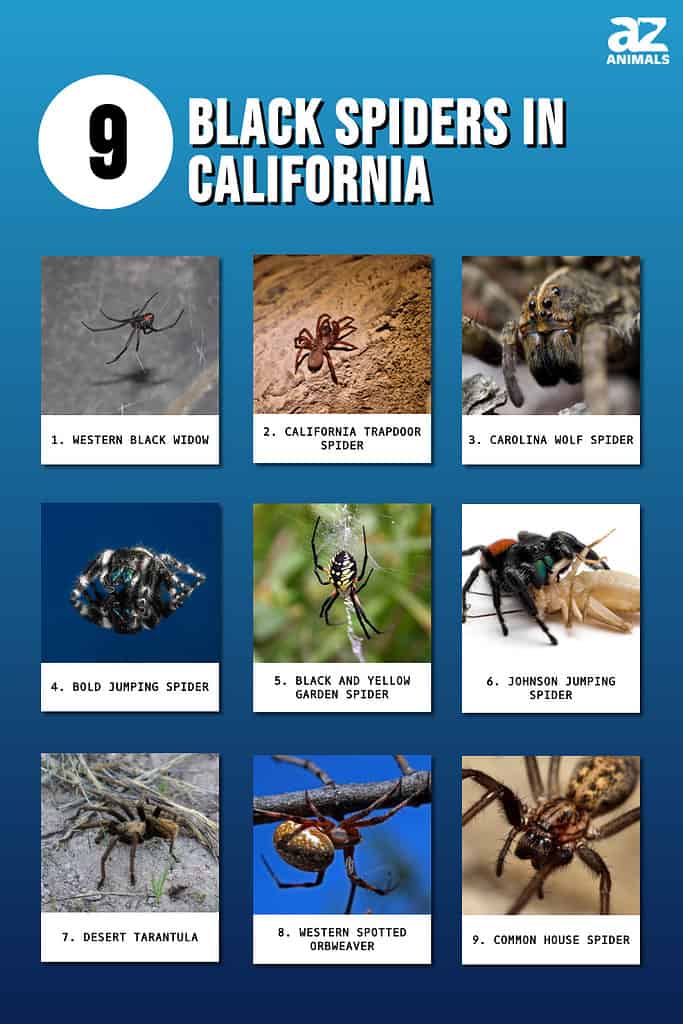
1. Western Black Widow
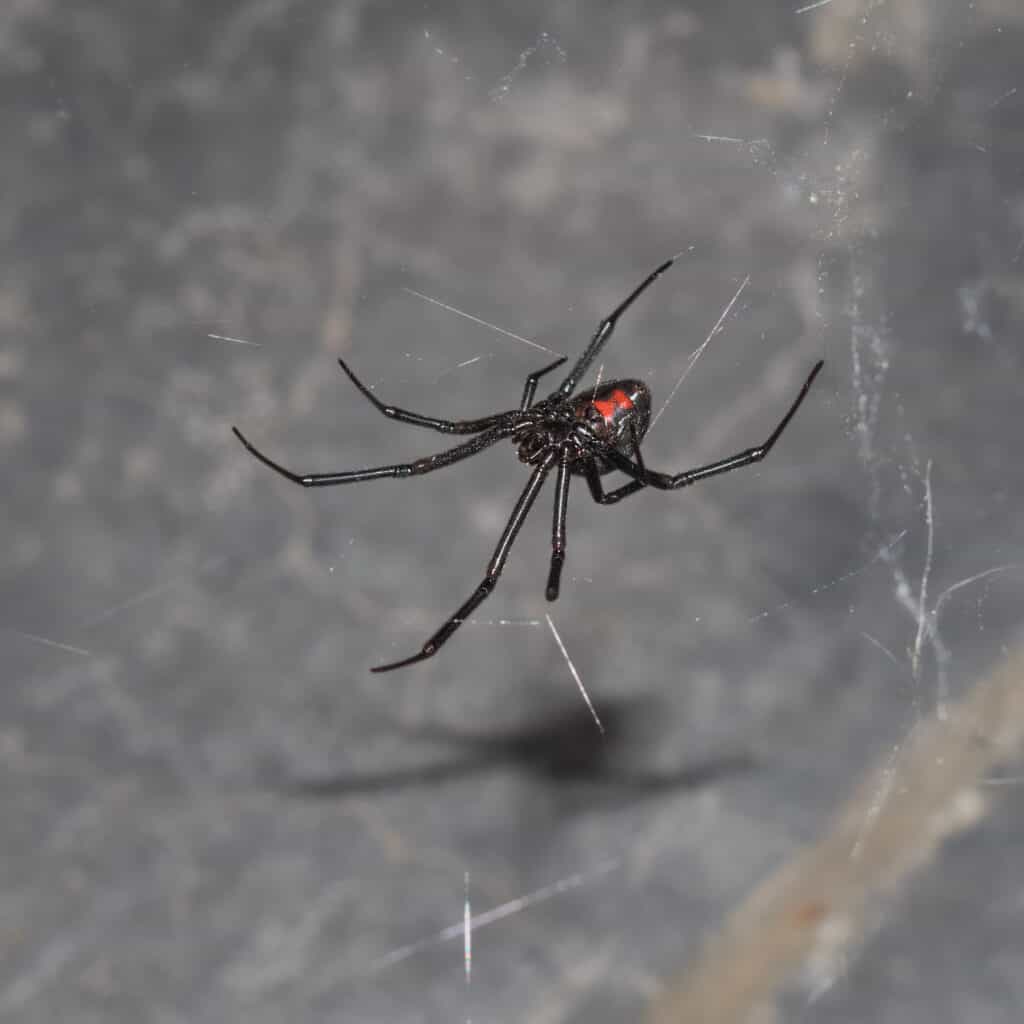
The females grow larger than the males, have black bodies, and a red, often hourglass-shaped mark in the center of their bellies.
©iStock.com/Shravan Sundaram Photography
Scientific Name: Latrodectus hesperus
Western black widows love nesting in a bit of clutter. They can usually be found enjoying debris-littered environments, and they may live underneath objects like rocks close to the ground. On occasion, they make their way indoors but that’s not typically their preference, as they would rather create sneaky homes in crevices and holes outdoors. These spiders are venomous and a human who suffers a bite may require medical attention. Luckily, these spiders are not aggressive and only bite if they feel threatened. The female western black widow is different than the male. These female spiders grow larger, have black bodies, and a red, often hourglass-shaped mark in the center of their bellies. They are also known for ruthlessly ingesting the male spider after they mate!
2. California Trapdoor Spider
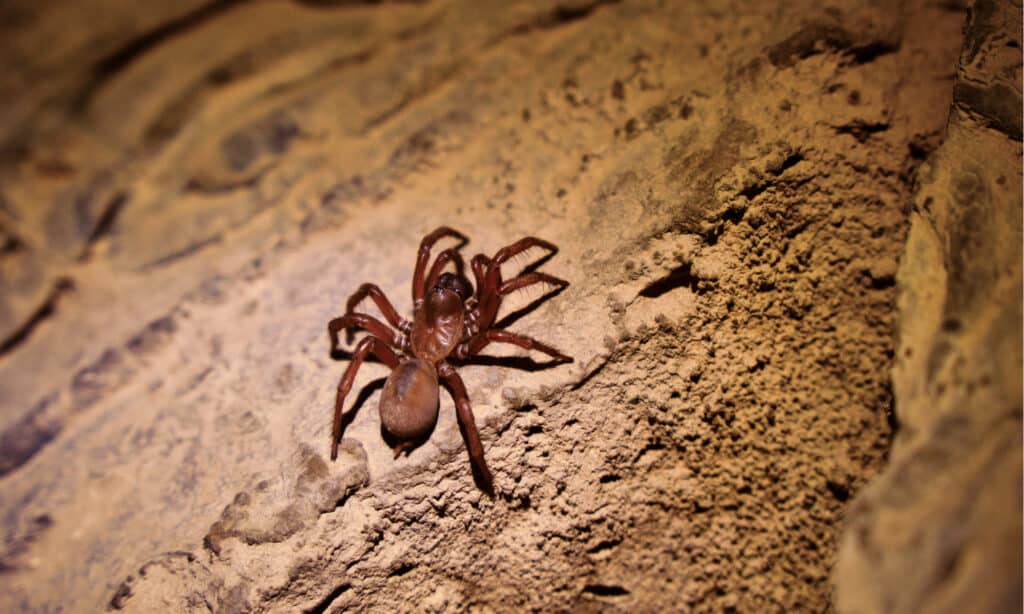
California trapdoor spiders are shiny black, brown, or yellow, and their bellies are more of a rust-stained brown.
©Geartooth Productions/Shutterstock.com
Scientific Name: Bothriocyrtum californicum
California trapdoor spiders are experts in home construction, neatly lining their space with silk and creating a D-shaped lid or “door,” which they keep closed most of the time. These little burrows are cylindrical and may be as deep as 8 inches and as wide as ¾ inches. They open the door to retrieve trapped prey. Females are somewhat introverted, never straying too far from home. These spiders look a lot like tarantulas, except they are a bit smaller and lack fur. Their hairless bodies are shiny black, brown, or yellow, but their bellies are more of a rust-stained brown. Females are larger than the males and after mating, they lay a couple hundred eggs. After the spiderlings hatch, the females care for them throughout the first winter.
3. Carolina Wolf Spider
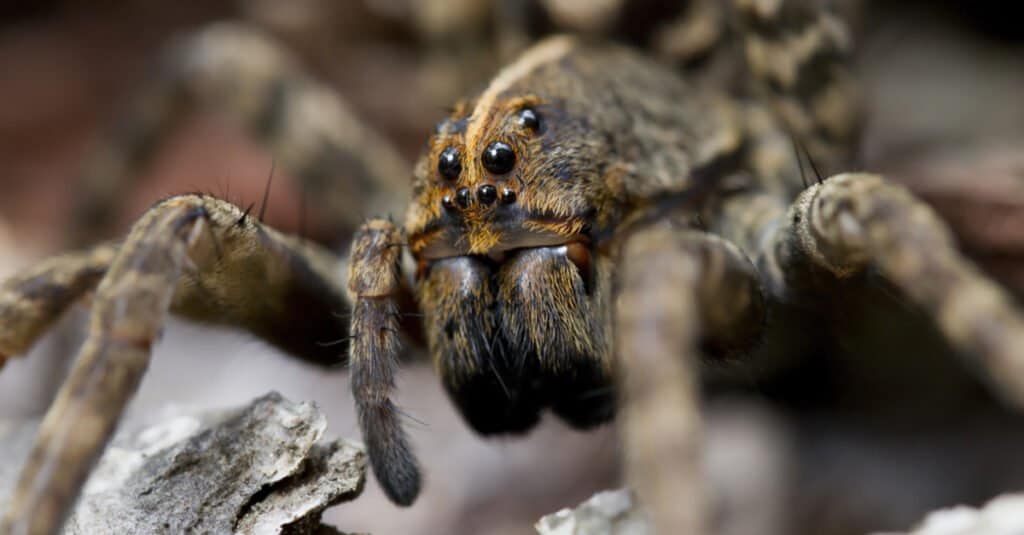
The Carolina Wolf Spider preys on insects and may make its way indoors in search of food.
©Will E. Davis/Shutterstock.com
Scientific Name: Hogna carolinensis
Whereas other spiders wait for prey to fall victim to their webs, Carolina wolf spiders take a much bolder approach. These venomous spiders actively hunt and don’t hesitate to attack. They are intimidatingly large and move with great speed. They may make an occasional appearance under the sun but they’re primarily nocturnal and hard to spot. Displaying either brown or black coloration, they camouflage beautifully with their preferred environments, which may be forest floors or near sandy coastlines. Because these spiders prey on insects, they may make their way indoors in search of food. Their bellies are almond-shaped, and their rear area is covered in a chevron-like pattern. The females are typically darker and larger. After mating, they create a silk-lined burrow, using plant debris as covering. They keep their egg sac on their backs and often carry their tiny spiderlings on their abdomens.
4. Bold Jumping Spider

Bold jumping spiders are black and hairy, and their abdomens have colored spots.
©iStock.com/JWJarrett
Scientific Name: Phidippus audax
Despite their name, bold jumping spiders are quite shy and generally retreat if a human approaches them. However, like wolf spiders, these are hunting spiders who don’t cast webs. They can jump great distances and feast on a variety of insects and some non-insects, like dragonflies and caterpillars. These spiders are black and hairy, and their abdomens have colored spots (white or yellow; orange if they’re young). The males look like they have eyebrows! The females grow larger, between 8 and 19 millimeters, whereas the males grow between 6 and 13 millimeters. They live in different environments, from under rocks or stones, to windowsills. These spiders are not nocturnal; instead, they use daylight and their incredible stereoscopic vision to stalk their prey. The females mate only once in early spring and suspend their eggs in a silk sheet within their homes.
5. Black and Yellow Garden Spider

Their webs are just as distinctive as their bodies, with a thick, zigzag-patterned center.
©iStock.com/AwakenedEye
Scientific Name: Argiope aurantia
The black and yellow garden spider goes by several names, including the golden garden spider, writing spider, and corn spider. It’s easily identified by its unique markings. On the abdomen, there are black and yellow shapes, and the cephalothorax is primarily white. These spiders set up their webs along tall vegetation, securing their environment away from the force of winds. They may build their webs under the edges of a roof or near a sun-drenched field. Their webs are just as distinctive as their bodies, with a thick, zigzag-patterned center.
6. Johnson Jumping Spider
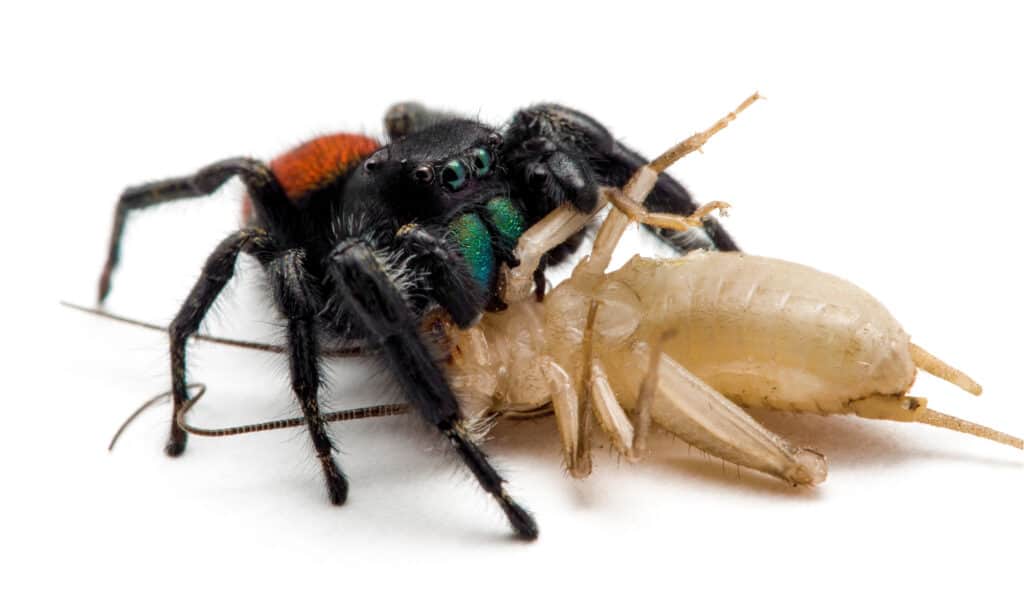
Johnson jumping spiders are capable of jumping great distances to hunt prey.
©Ernie Cooper/Shutterstock.com
Scientific Name: Phidippus johnsoni
The Johnson jumping spider is also known as the red-backed jumping spider, for obvious reasons. These spiders actively hunt for prey during the day and the females weave a funnel-shaped web when it’s time to lay their eggs. They look for crevices and concealed environments, like under stones, to stay safe. The males and females have slightly different appearances; males have a solid red belly, while females have a black line that runs through their red abdomen. These tiny dynamos are capable of jumping great distances to snatch their prey.
7. Desert Tarantula
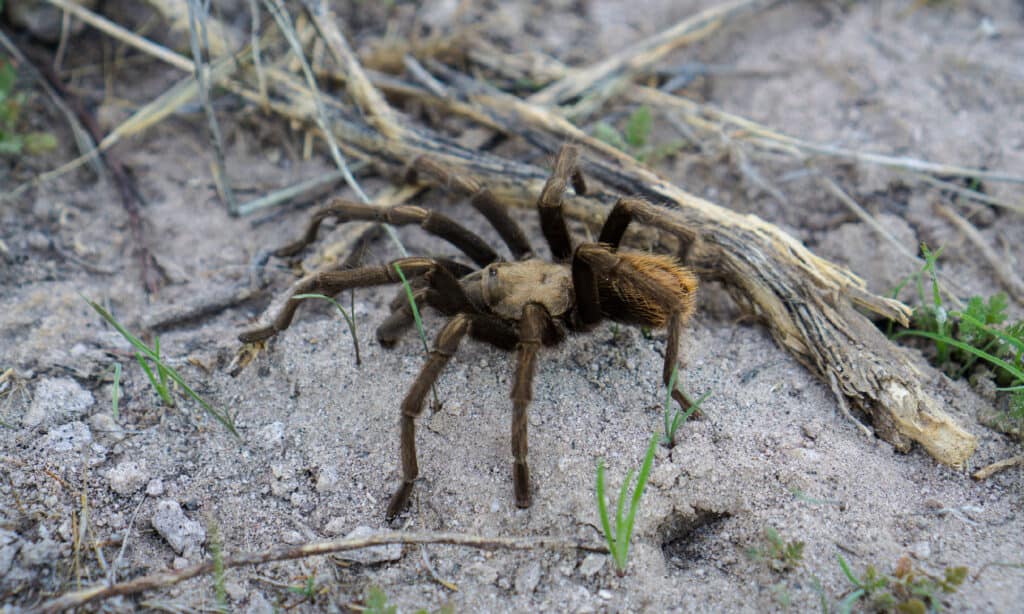
Some desert tarantulas are almost completely black while others are more of a dark brown.
©iStock.com/Stephen Couch
Scientific Name: Aphonopelma chalcodes
The desert tarantula has an ominous presence, but its personality contrasts its appearance. These arachnids are reclusive and docile. They are large, hairy spiders and their colorations vary. Some are almost completely black while others are more of a dark brown. Their legs grow to about 4 inches long and they weigh a couple of ounces. They don’t have great vision; they use their hair to help them sense prey and determine the wind’s direction. They have two fangs, which they use to inject venom into prey and ultimately liquefy it so they can enjoy a soup-like concoction.
8. Western Spotted Orbweaver
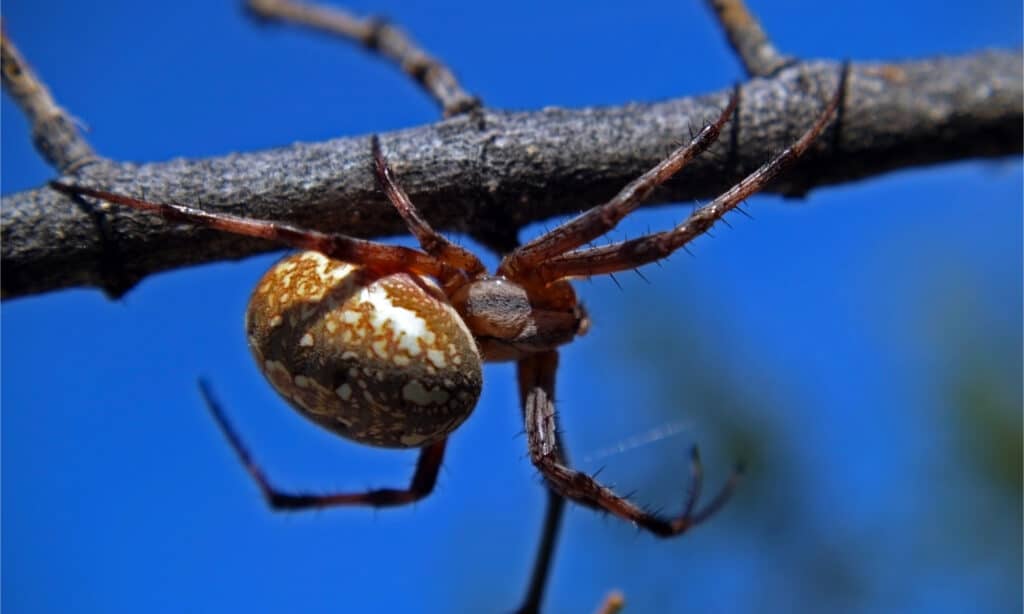
Western spotted orbweavers’ leg color can be yellow or red, but they always have black bands near their feet.
©Deep Desert Photography/Shutterstock.com
Scientific Name: Neoscona oaxacensis
Western spotted orbweavers create circular webs. Unlike species that prefer to hide, these spiders love setting up in open environments with scarce vegetation. They sit directly in the center of their circular web, upside down, and on full display, as they wait for insects to fall into their sticky silk. These include moths, flies, lice, and beetles. Their leg color can vary between yellow or red, but they always have black bands near their feet. Spotted orbweavers’ abdomens are globular, both brown and pale yellow. These spiders lay their eggs when fall rolls around and they hatch in the spring.
9. Common House Spider
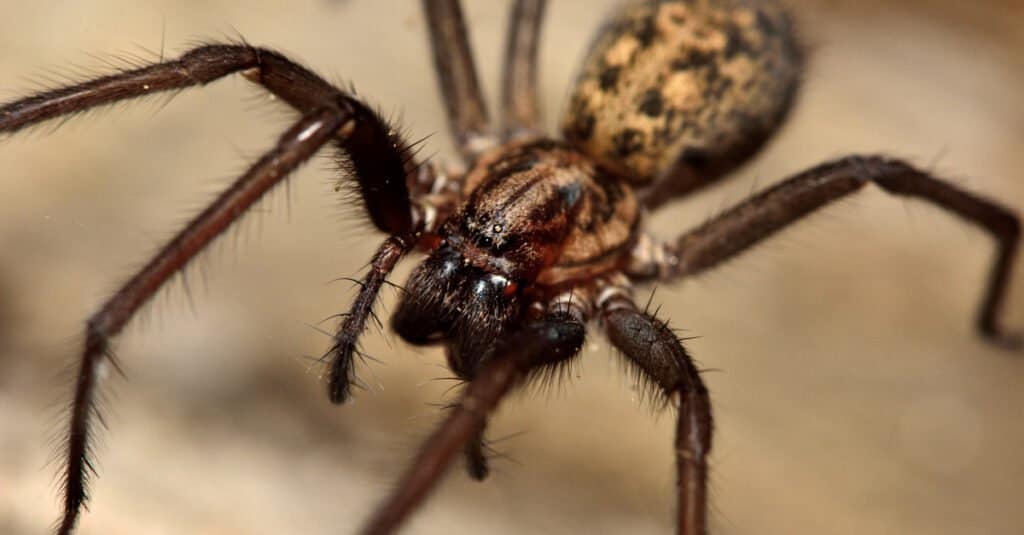
Their bulbous bellies make common house spiders appear almost like black widows, but are not nearly as dangerous.
©IanRedding/Shutterstock.com
Scientific Name: Parasteatoda tepidariorum
Common house spiders are solitary creatures that love a good room corner. They live in homes and other buildings because they prefer sheltered environments. These spiders are black, brown, and tan and are rather small, growing only up to a quarter of an inch in length. They are venomous but they do not harm pets or people. They feast on insects, which can be an effective form of pest control in the home. Like an adaptable fisherman, if it can’t get a catch, it moves to a more prime location. Since they’re dark and like shadowy corners, they’re not easy to spot. Their bulbous bellies make them appear almost like black widow spiders, but they are not nearly as dangerous.
Summary of 9 Black Spiders in California
Here’s a recap of the nine species of spiders featuring black colorations that are found in California.
| Number | Spider Species | Scientific Name |
|---|---|---|
| 1 | Western Black Widow | Latrodectus hesperus |
| 2 | California Trapdoor Spider | Bothriocyrtum californicum |
| 3 | Carolina Wolf Spider | Hogna carolinensis |
| 4 | Bold Jumping Spider | Phidippus audax |
| 5 | Black and Yellow Garden Spider | Argiope aurantia |
| 6 | Johnson Jumping Spider | Phidippus johnsoni |
| 7 | Desert Tarantula | Aphonopelma chalcodes |
| 8 | Western Spotted Orbweaver | Neoscona oaxacensis |
| 9 | Common House Spider | Parasteatoda tepidariorum |
The photo featured at the top of this post is © Peter Halasz (User:Pengo) / CC BY-SA 2.5 – License / Original
Thank you for reading! Have some feedback for us? Contact the AZ Animals editorial team.







